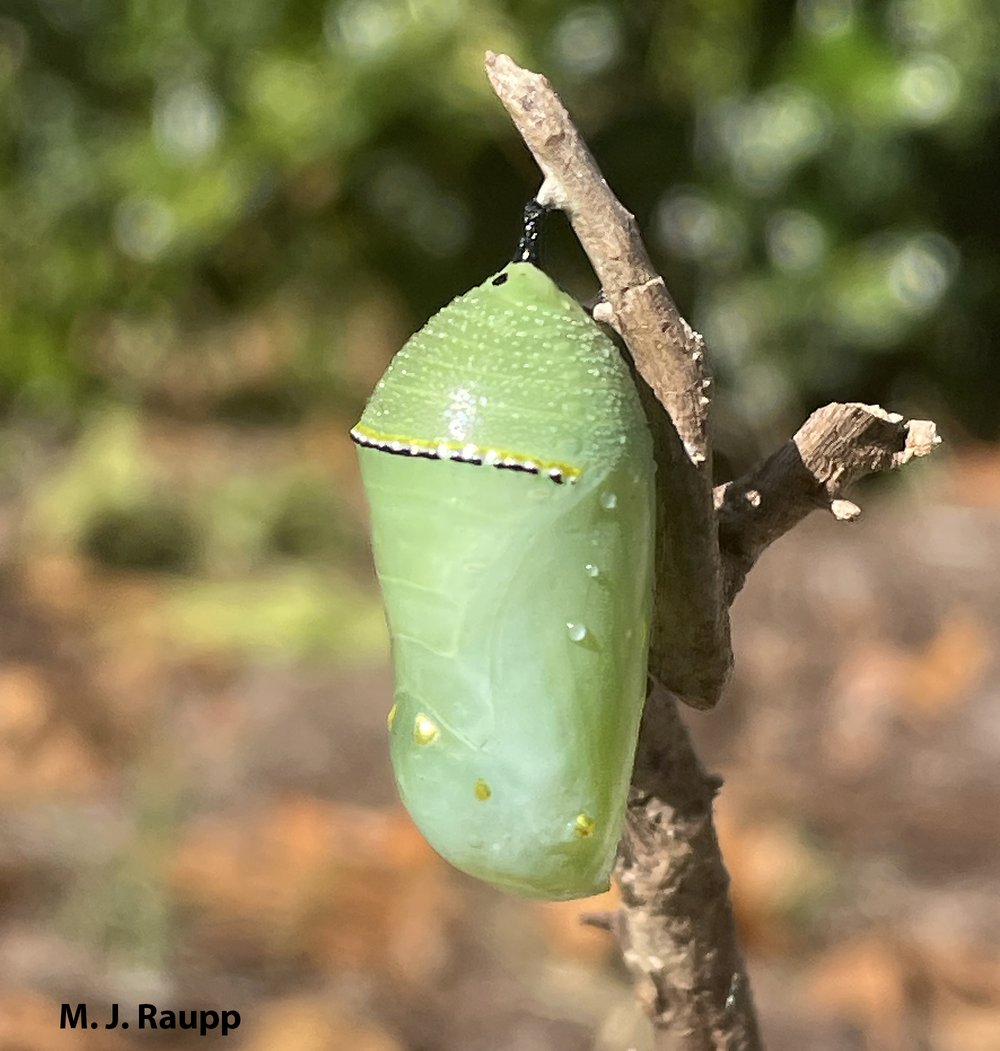Monarchs ring in the New Year at home: Non-migratory Monarch butterflies, Danaus plexippus

In parts of Florida where milkweeds and other flowering plants grow year-round, monarch butterflies abandoned the migratory life style and remain in the same region throughout the year. Even the week before Christmas, beautiful monarch chrysalises can be found.
A few weeks ago, we visited migratory insects that employed a “get out of town” strategy to avoid chilly temperatures. Among the most beloved of all of these vagabonds is the iconic monarch butterfly. We learned of the dramatic decline of migratory eastern and western populations of monarchs due to habitat destruction, pesticides, and global climate change in their overwintering refuges abroad and here in the United States. On December 10, 2024, the US Fish and Wildlife Service posted notice of its intent to seek protection of monarch butterflies under the endangered species act. The Fish and Wildlife Service has created a dynamite collection of resources to inform federal, tribal, state, and local governments, farmers and ranchers, managers of rights-of-way, home gardeners, educators, and international stakeholders on ways to help protect and conserve these remarkable insects.
Not all populations of monarchs are migratory. Unlike some North American monarchs that summer in northern latitudes and migrate to moderate southern locations to overwinter, several populations of monarchs abandoned their inherent migratory life styles in warm places like Florida and Hawai’i. In these locations benign temperatures with ample rainfall produce flowers with nectar for adults even in winter. A season-long supply of milkweeds for caterpillars enables monarchs to remain at home year-round completing multiple generations each year. In Jacksonville, Florida, a week before Christmas small twigs were decorated with gorgeous chrysalises soon to become striking monarch butterflies ready to celebrate the holidays.

Amidst the fallen leaves of a deciduous oak tree a fully grown monarch caterpillar prepares to pupate on the petiole of a leaf.
While lamenting the seasonal absence of monarchs in my Maryland garden, I was able to have one last visit with these royals on a post-Thanksgiving trip to Jacksonville, Florida. In parts of Florida and other southern states, non-migratory monarchs have taken up permanent residence in locations where milkweeds and other flowering plants flourish year-round. In a previous episode we met another population of non-migratory population of monarchs on the big island of Hawai’i. Elsewhere, other populations of non-migratory monarchs reside in far-flung lands including Pacific and Caribbean islands, countries in Europe, Central, and South America, Morocco, Australia, and New Zealand. A fascinating study revealed differences between migratory North American monarchs and non-migratory monarchs in Costa Rica. Costa Rican monarchs are descendants of migratory ancestors from North America. Scientists discovered that Costa Rican monarchs had significantly smaller forewings than their North American kin. Large wing size in North American monarchs is likely under strong selection and maintained to ensure success for monarchs destined to migrate hundreds or thousands of miles to overwintering sites. Through time, morphological traits such as long wings that support long distance migration apparently dwindled in non-migratory populations of monarchs.

Tropical milkweeds provide nectar and pollen for adult monarchs and nutritious leaves for monarch caterpillars throughout the year, affording monarchs the opportunity for year-round residence in Florida, Hawai’i, and several other states and lands around the world.
We all have a role to play in preserving our iconic monarch butterflies. The US Fish and Wildlife Service recommends that home gardeners plant pesticide-free, regionally native milkweeds and native nectar plants in their landscapes. Also, select a montage of pollinator attractors that bloom season-long to provide a continuous source of nectar and pollen for butterflies. Even if you have a small patio or balcony, you can enjoy supporting monarchs by using pollinator attractors that thrive in planters and containers. Many are already engaged in helping to preserve our iconic migratory monarchs. Here’s hoping more will join this effort in 2025 and beyond.
Bug of the Week wishes everyone a joyous New Year.
Acknowledgements
The information packed article “Fish and Wildlife Service Proposes Endangered Species Act Protection for Monarch Butterfly; Urges Increased Public Engagement to Help Save the Species” by Melissa Clark provided great insights into actions we can all take to help conserve monarch butterflies. “Seasonal plasticity in morphology and metabolism differs between migratory North American and resident Costa Rican monarch butterflies” by Ayşe Tenger-Trolander, Cole R. Julick, Wei Lu, Delbert André Green, Kristi L. Montooth, and Marcus R. Kronforst helped us understand how evolution shapes morphology and physiology on migratory and non-migratory populations of monarch butterflies. Special thanks to the Shrewsbury clan for providing habitat for monarch butterflies that served as the inspiration for this episode. You can learn more about protecting and enhancing pollinators in urban landscapes at this website: https://www.canr.msu.edu/home_gardening/uploads/files/pollinators/protectpollinatorsinlandscapes2019-web.pdf
This post appeared first on Bug of the Week


